| The Ants of Egypt - Genus Pheidole Westwood - key to minor workers |
Key to minors - MI = mandible index, from length of masticatory margin (upper angle to base of terminal tooth) ML; MI = (ML/HW) X 100; PI = (pronotum width/head width) X 100
| 1 |  TL
ca 1.7 mm; head near rectangular in full face view, with rounded
posterior corners; posterior dorsum of head coarsely reticulate;
postpetiole small and globular TL
ca 1.7 mm; head near rectangular in full face view, with rounded
posterior corners; posterior dorsum of head coarsely reticulate;
postpetiole small and globular |
fadli |
| -- | TL > 2.5 mm; | 2 |
| 2 | 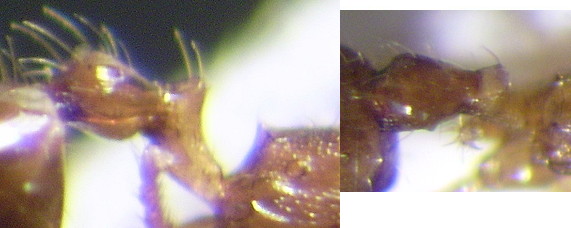 Postpetiole in profile distinctly longer than high and in
dorsal view distinctly longer than wide Postpetiole in profile distinctly longer than high and in
dorsal view distinctly longer than wide |
. |
| . |  TL ca 2.7 mm; CI 79, MI 40, SI 142, OI 30, PI 52; head in
full-face view wholly oval; anterior clypeal margin with three plus
pairs of long, stout, forward pointing hairs, the central pair set
close together; inner margin of mandible with an evenly sized row of
quite coarse teeth; lateral propodeum and petiole densely spiculate;
overall colour dark yellow-brown; mandibles and appendages paler TL ca 2.7 mm; CI 79, MI 40, SI 142, OI 30, PI 52; head in
full-face view wholly oval; anterior clypeal margin with three plus
pairs of long, stout, forward pointing hairs, the central pair set
close together; inner margin of mandible with an evenly sized row of
quite coarse teeth; lateral propodeum and petiole densely spiculate;
overall colour dark yellow-brown; mandibles and appendages paler |
megacephala |
| -- | Postpetiole in profile no more than slightly longer than high and longer than wide | 3 |
| 3 |  Postpetiole in profile somewhat flattened and slightly
longer than high, in dorsal view hexagonal; petiole profile cuneiform Postpetiole in profile somewhat flattened and slightly
longer than high, in dorsal view hexagonal; petiole profile cuneiform |
. |
| . |  TL
ca 2.7 mm; CI 79, MI 40, SI 142, OI 30, PI 52; funiculus segments 2-5
longer than wide; eyes near flat; head an elongated oval with a nuchal
collar; anterior clypeal margin with only two pairs of long forward
pointing hairs but with the central pair set at the edge of a median
straight section of the margin; with a mixture of minute teeth and
small teeth on the masticatory margin; and without two larger apical
teeth; erect pilosity long and quite fine; shiny with very little
sculpturation other than very fine longitudinal striations on the
lateral head and quite coarse puncturation on the lateral mesonotum and
the propodeum; overall yellow-brown with somewhat lighter appendages
and pedicel TL
ca 2.7 mm; CI 79, MI 40, SI 142, OI 30, PI 52; funiculus segments 2-5
longer than wide; eyes near flat; head an elongated oval with a nuchal
collar; anterior clypeal margin with only two pairs of long forward
pointing hairs but with the central pair set at the edge of a median
straight section of the margin; with a mixture of minute teeth and
small teeth on the masticatory margin; and without two larger apical
teeth; erect pilosity long and quite fine; shiny with very little
sculpturation other than very fine longitudinal striations on the
lateral head and quite coarse puncturation on the lateral mesonotum and
the propodeum; overall yellow-brown with somewhat lighter appendages
and pedicel |
sinaitica |
| -- | Postpetiole in profile spherical or nearly so | 4 |
| 4 |  Petiole with a short peduncle; postpetiole with a low
globular profile, from above globular and about twice as wide as the
petiole Petiole with a short peduncle; postpetiole with a low
globular profile, from above globular and about twice as wide as the
petiole |
. |
| . |  TL
ca 2.7 mm; CI 79, MI 28, SI 144-151, OI 33, PI 69; funiculus segments
2-5 length = width; head near square with rounded corners and a
distinct nuchal collar; eyes large and convex, clypeus weakly but
distinctly carinate, with rectangular anterior margin; anterior clypeal
margin with at least two pairs of long forward pointing hairs and with
the central pair set at the edge of a median weakly convex section
of the margin; mandibles relatively short, with a distinctive
sharply curved outer margin; the teeth are coarse and relatively large;
and with two small apical teeth; frontal area distinctly but
shallowly impressed;very shiny with very little sculpturation other
than very fine longitudinal striations on the lateral head and fine
puncturation on the lateral mesonotum and the propodeum; red-brown, the
Israel specimens being darker, with somewhat lighter appendages and
pedicel TL
ca 2.7 mm; CI 79, MI 28, SI 144-151, OI 33, PI 69; funiculus segments
2-5 length = width; head near square with rounded corners and a
distinct nuchal collar; eyes large and convex, clypeus weakly but
distinctly carinate, with rectangular anterior margin; anterior clypeal
margin with at least two pairs of long forward pointing hairs and with
the central pair set at the edge of a median weakly convex section
of the margin; mandibles relatively short, with a distinctive
sharply curved outer margin; the teeth are coarse and relatively large;
and with two small apical teeth; frontal area distinctly but
shallowly impressed;very shiny with very little sculpturation other
than very fine longitudinal striations on the lateral head and fine
puncturation on the lateral mesonotum and the propodeum; red-brown, the
Israel specimens being darker, with somewhat lighter appendages and
pedicel |
jordanica |
| -- | Postpetiole seen from above wider than long | 5 |
| 5 |  Postpetiole profile a high angular dome, from above
anterior widening in a straightish line to the mid-point, posteriorly a
smooth convex arc Postpetiole profile a high angular dome, from above
anterior widening in a straightish line to the mid-point, posteriorly a
smooth convex arc |
. |
| . | 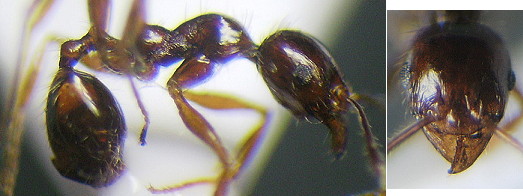 TL
ca 2.7 mm; CI 88, SI 118, OI 29, MI 40, PI 55; generally narrower and
more slender than the other species, with a weakly rectangular full
face appearance, without a nuchal collar; eye circular, quite large but
only weakly convex; mandibles unusually large and long, with only
minute teeth on the masticatory margin and without a distinct apical
tooth; clypeus with the anterior margin weakly impressed but without a
median or any other carinae and with only fine, not very conspicuous
forward facing long hairs; frontal area distinctly and quite deeply
impressed; pronotum relatively narrow, longitudinally ovoid;
alitrunk profile with promesonotum shallowly convex with the
pro-mesonotal suture very slightly impressed so as to interrupt the
profile; the metanotal groove is distinct but shallowly impressed both
dorsally and laterally; the propodeum with the dorsum convex in profile
and weak lateral margination culminating in small angular prominences
rather than teeth, the declivity is weakly concave; erect hairs
relatively coarse; generally very shiny; fairly uniform dark chestnut
brown with mandibles, legs and petiole peduncle lighter orange-red TL
ca 2.7 mm; CI 88, SI 118, OI 29, MI 40, PI 55; generally narrower and
more slender than the other species, with a weakly rectangular full
face appearance, without a nuchal collar; eye circular, quite large but
only weakly convex; mandibles unusually large and long, with only
minute teeth on the masticatory margin and without a distinct apical
tooth; clypeus with the anterior margin weakly impressed but without a
median or any other carinae and with only fine, not very conspicuous
forward facing long hairs; frontal area distinctly and quite deeply
impressed; pronotum relatively narrow, longitudinally ovoid;
alitrunk profile with promesonotum shallowly convex with the
pro-mesonotal suture very slightly impressed so as to interrupt the
profile; the metanotal groove is distinct but shallowly impressed both
dorsally and laterally; the propodeum with the dorsum convex in profile
and weak lateral margination culminating in small angular prominences
rather than teeth, the declivity is weakly concave; erect hairs
relatively coarse; generally very shiny; fairly uniform dark chestnut
brown with mandibles, legs and petiole peduncle lighter orange-red |
laticeps |
| -- | Postpetiole with low domed upper half in profile and a near flat ventral part, from above a slightly offset oval | 6 |
| 6 | Viewed in profile the alitrunk has a distinct transverse mesonotal welt | 7 |
| -- | Viewed in profile the promesonotum is a continuous shallow curve | 8 |
| 7 | 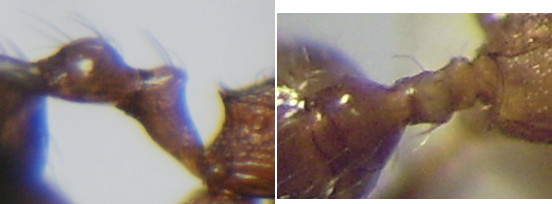 Post-petiole simply ovoid in dorsal view Post-petiole simply ovoid in dorsal view |
. |
| . |  TL ca
2.5-2.7, HW ca 0.50-0.56, HL 0.60-0.62, SL 0.62-0.67, PW 0.31. Head a
somewhat elongated oval; with a narrow nuchal collar. In profile the
head is ovoid, with a weakly convex underside that has a concave area
towards the posterior; the dorsum is more evenly convex. Mandibles
long, with a strongly curved outer margin, apically the curve
intensifies; the teeth are quite small; and with two small apical
teeth. Anterior margin of clypeus straight or very shallowly impressed,
without a median or any other carinae; with four-six usually quite fine
forward facing long hairs; clypeus weakly convex and not obviously
visible from the side. Frontal carinae very short and parallel; set
quite far apart, almost half the width of the head at the level of the
antennal insertions. Scapes moderately long and thick, expanding
distinctly in the apical third, surpassing the occiput by no more than
1/5 of their length; funiculus about 25% longer than scape; the
3-segmented club has the apical segment only about one-third longer
than the pre-apical segment; the pre-apical segments are about twice as
long as they are wide; the club is about the same length as the rest of
the funiculus. The eye is quite small and moderately strongly convex;
weakly ovoid not much longer than wide (12 facets X 10 facets); the
anteriormost point is less than its own length back from the anterior
point of the genae. The alitrunk profile has the promesonotum evenly
convex with the pro-mesonotal suture shallowly interrupting the
profile; the anterior of the mesonotum is raised into a low transverse
welt; the metanotal groove is distinct but shallowly impressed both
dorsally and laterally; the propodeum has the dorsum weakly convex in
profile and very faint lateral margination culminating in small
triangular teeth, the declivity is almost vertical. The petiole has
quite a short peduncle and a low triangular profile, with the apex
rounded; the postpetiole has a low globular profile and from above is
near circular and about 1.5 X the width of the petiole. The gaster is
narrowly ovoid viewed from above but globular in profile; it has no
obvious anterior margin. The legs are relatively long with moderately
swollen femora. The whole of the head, body, antennae and legs bear
fine, moderately long, erect hairs; these are fairly abundant on the
head, both dorsally and ventrally. The scapes and legs have short
decumbent and inconspicuous hairs. Overall very shiny with very little
sculpturation other than puncturation on the whole of the mesonotum and
the propodeum. Also the genae have three or four curved rugae. Overall
yellow-brown or red-brown, with the gaster and head often darker than
the rest of the body and appendages ("teneriffana" in part) TL ca
2.5-2.7, HW ca 0.50-0.56, HL 0.60-0.62, SL 0.62-0.67, PW 0.31. Head a
somewhat elongated oval; with a narrow nuchal collar. In profile the
head is ovoid, with a weakly convex underside that has a concave area
towards the posterior; the dorsum is more evenly convex. Mandibles
long, with a strongly curved outer margin, apically the curve
intensifies; the teeth are quite small; and with two small apical
teeth. Anterior margin of clypeus straight or very shallowly impressed,
without a median or any other carinae; with four-six usually quite fine
forward facing long hairs; clypeus weakly convex and not obviously
visible from the side. Frontal carinae very short and parallel; set
quite far apart, almost half the width of the head at the level of the
antennal insertions. Scapes moderately long and thick, expanding
distinctly in the apical third, surpassing the occiput by no more than
1/5 of their length; funiculus about 25% longer than scape; the
3-segmented club has the apical segment only about one-third longer
than the pre-apical segment; the pre-apical segments are about twice as
long as they are wide; the club is about the same length as the rest of
the funiculus. The eye is quite small and moderately strongly convex;
weakly ovoid not much longer than wide (12 facets X 10 facets); the
anteriormost point is less than its own length back from the anterior
point of the genae. The alitrunk profile has the promesonotum evenly
convex with the pro-mesonotal suture shallowly interrupting the
profile; the anterior of the mesonotum is raised into a low transverse
welt; the metanotal groove is distinct but shallowly impressed both
dorsally and laterally; the propodeum has the dorsum weakly convex in
profile and very faint lateral margination culminating in small
triangular teeth, the declivity is almost vertical. The petiole has
quite a short peduncle and a low triangular profile, with the apex
rounded; the postpetiole has a low globular profile and from above is
near circular and about 1.5 X the width of the petiole. The gaster is
narrowly ovoid viewed from above but globular in profile; it has no
obvious anterior margin. The legs are relatively long with moderately
swollen femora. The whole of the head, body, antennae and legs bear
fine, moderately long, erect hairs; these are fairly abundant on the
head, both dorsally and ventrally. The scapes and legs have short
decumbent and inconspicuous hairs. Overall very shiny with very little
sculpturation other than puncturation on the whole of the mesonotum and
the propodeum. Also the genae have three or four curved rugae. Overall
yellow-brown or red-brown, with the gaster and head often darker than
the rest of the body and appendages ("teneriffana" in part) |
fervens |
| -- | 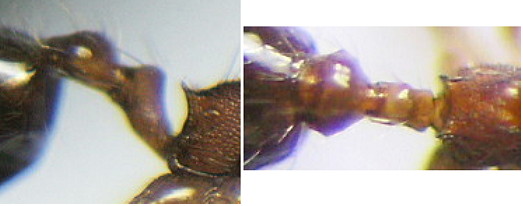 |
. |
| . | 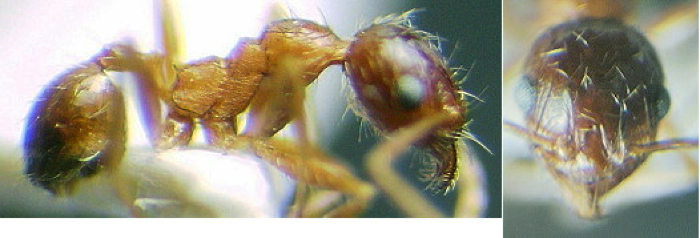 TL
ca 2.7, CI 80, SI 137, OI 34, MI 30-33, PI 67; head a shorter oval
(Iran and Qaliobyia specimens more square); with a very narrow nuchal
collar. In profile the head evenly ovoid, with the anterior margin
deeply incised by the mandibular insertion. The mandibles are long,
with an evenly curved outer margin; the teeth are coarse and relatively
large; and with two small apical teeth. The clypeus is markedly convex,
with sharply defined lateral carinae. The anterior margin of the
clypeus is straight, without a median carina; the margin has four
conspicuous forward facing long hairs. Frontal carinae short, but reach
back to beyond the anterior of the eye; they are weakly divergent
posteriorly and are set quite close together, just over one-third the
width of the head at the level of the antennal insertions. The scapes
are long and slender, thickening only very slightly in the apical
third, surpassing the occiput by about one-quarter of their length;
funiculus about 25% longer than scape; the 3-segmented club has the
apical segment only about one-third longer than the pre-apical segment;
the pre-apical segments are about twice as long as they are wide; the
club is about the same length as the rest of the funiculus. The eye is
unusually large, almost circular and strongly convex; the anteriormost
point is less than its own length back from the anterior point of the
genae. The alitrunk profile has the promesonotum evenly and shallowly
convex with the pro-mesonotal suture quite pronounced and interrupting
the profile, also being incised laterally; the anterior of the
mesonotum is raised into a distinct but low transverse welt; the
metanotal groove is distinct but shallowly impressed both dorsally and
laterally, with cross-ribs in the lateral part; the propodeum has the
dorsum very weakly convex in profile and narrow lateral margination
culminating in relatively large triangular teeth, the declivity is
weakly concave. The petiole has quite a short narrow peduncle and a low
triangular profile, with the apex rounded; the postpetiole has a low
profile globular above but near flat below; from above the postpetiole
is simply ovoid and about twice as wide as the petiole. The gaster is
narrowly ovoid viewed from above but globular in profile; it has no
obvious anterior margin. The legs are relatively long with weakly
swollen femora. The whole of the head, body, antennae and legs bear
fine, long, erect hairs; these are fairly abundant on the head, both
dorsally and ventrally. Short oblique erect hairs give the scapes and
legs a bristly appearance. Overall very shiny with very little
sculpturation other than quite coarse puncturation on the lateral
mesonotum and the whole of the propodeum. The genae have sharp carinae
rounding around above the eye. Overall red-brown, most with the head
and gaster darker than the alitrunk, with somewhat lighter appendages
and pedicel ("teneriffana" in part) TL
ca 2.7, CI 80, SI 137, OI 34, MI 30-33, PI 67; head a shorter oval
(Iran and Qaliobyia specimens more square); with a very narrow nuchal
collar. In profile the head evenly ovoid, with the anterior margin
deeply incised by the mandibular insertion. The mandibles are long,
with an evenly curved outer margin; the teeth are coarse and relatively
large; and with two small apical teeth. The clypeus is markedly convex,
with sharply defined lateral carinae. The anterior margin of the
clypeus is straight, without a median carina; the margin has four
conspicuous forward facing long hairs. Frontal carinae short, but reach
back to beyond the anterior of the eye; they are weakly divergent
posteriorly and are set quite close together, just over one-third the
width of the head at the level of the antennal insertions. The scapes
are long and slender, thickening only very slightly in the apical
third, surpassing the occiput by about one-quarter of their length;
funiculus about 25% longer than scape; the 3-segmented club has the
apical segment only about one-third longer than the pre-apical segment;
the pre-apical segments are about twice as long as they are wide; the
club is about the same length as the rest of the funiculus. The eye is
unusually large, almost circular and strongly convex; the anteriormost
point is less than its own length back from the anterior point of the
genae. The alitrunk profile has the promesonotum evenly and shallowly
convex with the pro-mesonotal suture quite pronounced and interrupting
the profile, also being incised laterally; the anterior of the
mesonotum is raised into a distinct but low transverse welt; the
metanotal groove is distinct but shallowly impressed both dorsally and
laterally, with cross-ribs in the lateral part; the propodeum has the
dorsum very weakly convex in profile and narrow lateral margination
culminating in relatively large triangular teeth, the declivity is
weakly concave. The petiole has quite a short narrow peduncle and a low
triangular profile, with the apex rounded; the postpetiole has a low
profile globular above but near flat below; from above the postpetiole
is simply ovoid and about twice as wide as the petiole. The gaster is
narrowly ovoid viewed from above but globular in profile; it has no
obvious anterior margin. The legs are relatively long with weakly
swollen femora. The whole of the head, body, antennae and legs bear
fine, long, erect hairs; these are fairly abundant on the head, both
dorsally and ventrally. Short oblique erect hairs give the scapes and
legs a bristly appearance. Overall very shiny with very little
sculpturation other than quite coarse puncturation on the lateral
mesonotum and the whole of the propodeum. The genae have sharp carinae
rounding around above the eye. Overall red-brown, most with the head
and gaster darker than the alitrunk, with somewhat lighter appendages
and pedicel ("teneriffana" in part) |
providens |
| . | Mesonotum not raised into a welt - pallidula-group, minors difficult to separate | . |
| 8 | 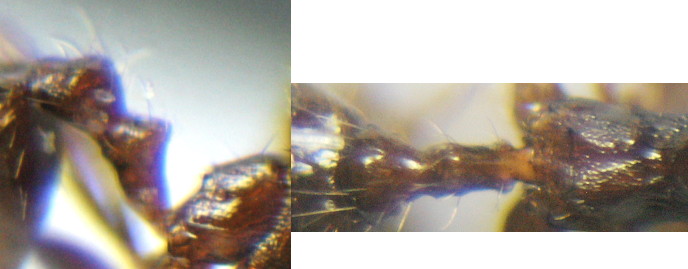 Head a short rectangle with the sides very weakly convex,
posterior angles broad and evenly rounded, the occiput straight; Head a short rectangle with the sides very weakly convex,
posterior angles broad and evenly rounded, the occiput straight; |
. |
| . |  TL ca 2.3 mm CI 87 SI 120 OI 28 MI 36 PI 60; with a very
narrow nuchal collar; mandibles moderately long, with a mixture of
minute teeth and quite coarse teeth on the masticatory margin; and two
larger apical teeth; anterior margin of clypeus quite strongly convex,
without a median or any other carinae; with only four forward facing,
fine long hairs; TL ca 2.3 mm CI 87 SI 120 OI 28 MI 36 PI 60; with a very
narrow nuchal collar; mandibles moderately long, with a mixture of
minute teeth and quite coarse teeth on the masticatory margin; and two
larger apical teeth; anterior margin of clypeus quite strongly convex,
without a median or any other carinae; with only four forward facing,
fine long hairs; |
Egypt - tristis |
| -- | In full face view the head a somewhat elongated oval with widely rounded posterior corners; TL > 2.5 mm | 9 |
| 9 | 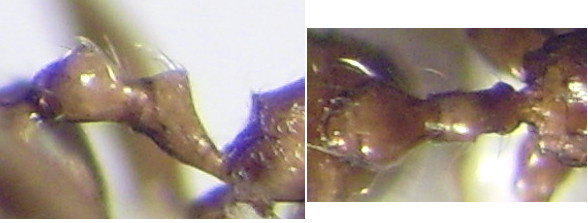 Mesonotum only shallowly raised; metanotal
groove narrow and marked rather than impressed; propodeal spines small Mesonotum only shallowly raised; metanotal
groove narrow and marked rather than impressed; propodeal spines small |
. |
| . |  CI
83 SI 123 OI 25 MI 28 PI 65 - Croatia (Antweb); CI 87 SI 121 OI 26 MI
33 PI 63 - Egypt; head subrectangular with no more than weakly convex
sides but rounded posterior angles and a slight median convexity of the
occiput; without a nuchal collar; inner margin of mandible with an
evenly sized row of quite small teeth; anterior margin of the clypeus
is evenly but shallowly convex and is completely smooth; with a central
pair of conspicuous forward facing long hairs and finer, shorter,
lateral hairs The frontal carinae are very short and almost parallel;
set quite close together, about one-third the width of the head at the
level of the antennal insertions; frontal area distinctly delineated
but not impressed at all; propodeal spines missing or highly reduced;
lateral propodeum and petiole smooth and shiny; overall colour
yellow-brown CI
83 SI 123 OI 25 MI 28 PI 65 - Croatia (Antweb); CI 87 SI 121 OI 26 MI
33 PI 63 - Egypt; head subrectangular with no more than weakly convex
sides but rounded posterior angles and a slight median convexity of the
occiput; without a nuchal collar; inner margin of mandible with an
evenly sized row of quite small teeth; anterior margin of the clypeus
is evenly but shallowly convex and is completely smooth; with a central
pair of conspicuous forward facing long hairs and finer, shorter,
lateral hairs The frontal carinae are very short and almost parallel;
set quite close together, about one-third the width of the head at the
level of the antennal insertions; frontal area distinctly delineated
but not impressed at all; propodeal spines missing or highly reduced;
lateral propodeum and petiole smooth and shiny; overall colour
yellow-brown |
pallidula |
| -- | 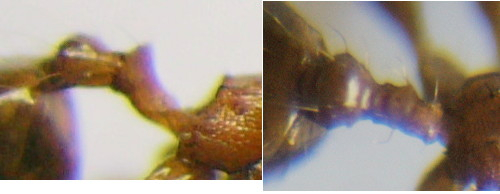 |
. |
| . |  TL
ca 2.7 mm; CI 87 SI 120 OI 28 MI 25 PI 68; head with sides strongly
convex, posterior angles rounded in a near continuous curve with the
convex occiput; with a very narrow nuchal collar; mandibles moderately
long, with quite coarse teeth on the masticatory margin; and with two
large apical teeth; anterior margin of clypeus very weakly concave
medially, without a median or any other carinae; with only four
conspicuous forward facing long hairs; frontal carinae short but very
slightly wider apart at posterior limit; set quite far apart, about 0.4
the width of the head at the level of the antennal insertions; the
frontal area (notch) is distinctly and quite deeply impressed; shiny,
chestnut brown with no significantly lighter areas TL
ca 2.7 mm; CI 87 SI 120 OI 28 MI 25 PI 68; head with sides strongly
convex, posterior angles rounded in a near continuous curve with the
convex occiput; with a very narrow nuchal collar; mandibles moderately
long, with quite coarse teeth on the masticatory margin; and with two
large apical teeth; anterior margin of clypeus very weakly concave
medially, without a median or any other carinae; with only four
conspicuous forward facing long hairs; frontal carinae short but very
slightly wider apart at posterior limit; set quite far apart, about 0.4
the width of the head at the level of the antennal insertions; the
frontal area (notch) is distinctly and quite deeply impressed; shiny,
chestnut brown with no significantly lighter areas |
arenarum |
| . | 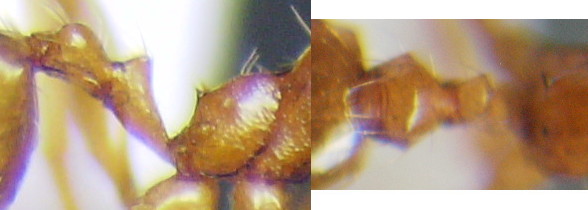 . . |
. |
| . |  TL ca 2.8 mm; CI 87 SI 125 OI 25 MI 35 PI 52; head with
sides weakly convex, posterior angles broad and evenly rounded, the
anterior is only about 0.7 the width of the posterior widest point;
with a very fine nuchal collar; mandibles long, with small coarse teeth
on the masticatory margin; and with only small apical teeth; anterior
margin of clypeus very weakly convex, without a median or any other
carinae; with only four slender forward facing long hairs; lateral
propodeum and petiole almost smooth and shiny; propodeal spines missing
or highly reduced; overall colour yellow-brown TL ca 2.8 mm; CI 87 SI 125 OI 25 MI 35 PI 52; head with
sides weakly convex, posterior angles broad and evenly rounded, the
anterior is only about 0.7 the width of the posterior widest point;
with a very fine nuchal collar; mandibles long, with small coarse teeth
on the masticatory margin; and with only small apical teeth; anterior
margin of clypeus very weakly convex, without a median or any other
carinae; with only four slender forward facing long hairs; lateral
propodeum and petiole almost smooth and shiny; propodeal spines missing
or highly reduced; overall colour yellow-brown |
orientalis |
|
©2009, 2015 - Brian
Taylor CBiol FRSB FRES 11, Grazingfield, Wilford, Nottingham, NG11 7FN, U.K. |
href="pheidole_minor_key.htm"